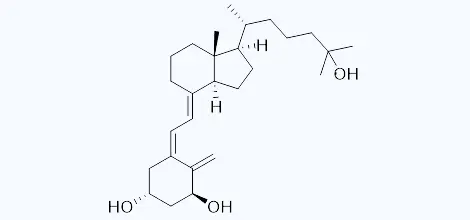Mechanism of Action :
Man's natural supply of vitamin D depends mainly on exposure to the ultraviolet rays of the sun for conversion of 7-dehydrocholesterol in the skin to vitamin D3 (cholecalciferol). Vitamin D3 must be metabolically activated in the liver and the kidney before it is fully active as a regulator of calcium and phosphorus metabolism at target tissues. The initial transformation of vitamin D3 is catalyzed by a vitamin D3-25-hydroxylase enzyme (25-OHase) present in the liver, and the product of this reaction is 25-hydroxyvitamin D3 [25-(OH)D3]. Hydroxylation of 25-(OH)D3 occurs in the mitochondria of kidney tissue, activated by the renal 25-hydroxyvitamin D3-1 alpha-hydroxylase (alpha-OHase), to produce 1,25-(OH)2D3 (calcitriol), the active form of vitamin D3. Endogenous synthesis and catabolism of calcitriol, as well as physiological control mechanisms affecting these processes, play a critical role regulating the serum level of calcitriol.
Indication :
Predialysis Patients: Calcitriol is indicated in the of secondary hyperparathyroidism and resultant metabolic bone disease in patients with moderate to severe chronic renal failure (Ccr 15 to 55 mL/min) not yet on dialysis. In children, the creatinine clearance value must be corrected for a surface area of 1.73 square meters. A serum iPTH level of ³ 100 pg/mL is strongly suggestive of secondary hyperparathyroidism.
Dialysis Patients: Calcitriol is indicated in the management of hypocalcemia and the resultant metabolic bone disease in patients undergoing chronic renal dialysis. In these patients, Rocaltrol administration enhances calcium absorption, reduces serum alkaline phosphatase levels and may reduce elevated parathyroid hormone levels and the histological manifestations of osteitis fibrosa cystica and defective mineralization.
Hypoparathyroidism Patients: Calcitriol is also indicated in the management of hypocalcemia and its clinical manifestations in patients with postsurgical hypoparathyroidism, idiopathic hypoparathyroidism, and pseudohypoparathyroidism.
